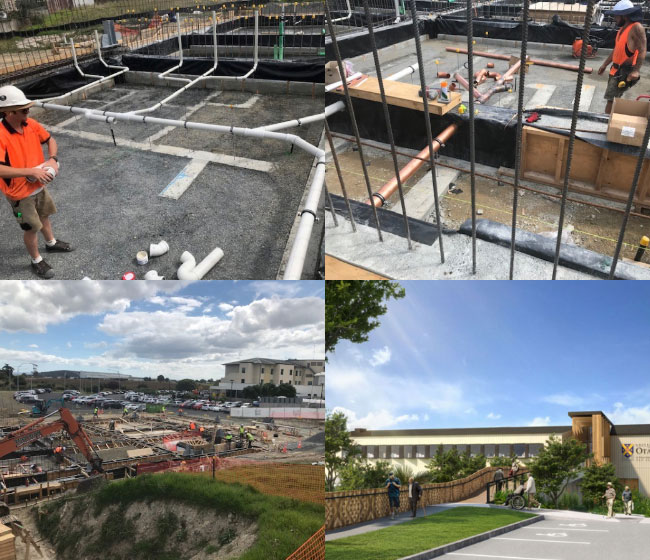Thursday 4 April 2019 1:30pm

Counties Manukau building progress … (clockwise from bottom left) the site for the new dental teaching facility and patient treatment clinic from the east with cars in the new car park and the project in the background, drain pipes that will be under the concrete slab floors, reinforcing steel and pipes for other services that will also be beneath the slab floors, and an illustration showing how the completed building will look.
Construction of the University’s dental teaching facility and patient treatment clinic in South Auckland is proceeding well, with structural steel now being ordered, Campus Development Division Director David Perry says.
Building began on the $28.31 million, two-storey, 32-chair building in mid-December 2018 on land owned by the Counties Manukau District Health Board, beside its Manukau SuperClinic on Great South Road.
Tasks completed
The first task was to build a new car park to replace a SuperClinic car park that is being used to access the site and this car park will eventually become the dental facility’s carpark. This car park was completed a week ahead of programme and is now being used by the SuperClinic.
Piling for the clinic was also finished five days ahead of schedule – the work started in mid-December and finished at the end of January.
Now the project is out of the ground, concrete is now being poured for ground beams for the foundation slab and the structural steel is being ordered, Mr Perry says, while crediting Project Director Jamie Cargill and main contractor Savory Construction for the efficient work.
The project is on target for completion before the start of the academic year in 2020, all going to plan.
Purpose
The new dental clinic aims to help meet high health needs, while providing students with wide-ranging learning opportunities in a diverse community that will increase their understanding of people from a range of backgrounds, Pro-Vice-Chancellor of the Division of Health Sciences Professor Paul Brunton says.
The Counties Manukau Health Board provides services to 11 per cent of New Zealand’s population, including 12 per cent of New Zealand’s Māori, 37 per cent of New Zealand’s Pacific people, and 21 per cent of New Zealand’s Asian people.
The project will strengthen relationships and partnerships with Māori and Pacific communities based on mutually beneficial goals incorporating patient care, research and education.
Not only will the Faculty of Dentistry regularly consult the community to find out what it needs from the clinics then work to deliver that, the Faculty will also provide a wide range of outreach activities.
The clinic will follow the long-standing social contract model operated successfully in Dunedin, where patients receive treatment provided by students under supervision at a highly accessible cost, he says.
Education
At any one time, 48 final-year Bachelor of Dental Surgery students will be assigned to the Counties Manukau facility.
Having an Auckland base in an area home to a large number of oral healthcare professionals will also make it easier for them to access continuing education opportunities.
The facility could help meet international demand for upskilling dentists as well, because Auckland is so accessible, Professor Brunton says.
National centre
The University of Otago has been home to New Zealand’s national centre of dentistry since 1907.
The Faculty of Dentistry in Dunedin carries out about 76,000 treatments annually in the city for the public from around the lower South Island.
The Faculty also includes the Sir John Walsh Research Institute and undergraduate and postgraduate programmes in dentistry, oral health and dental technology.
